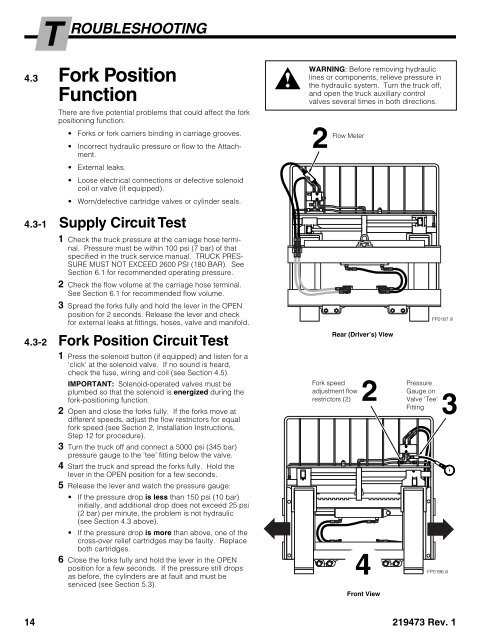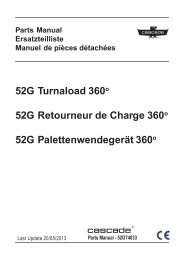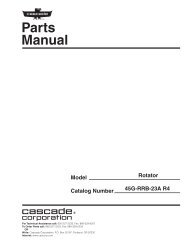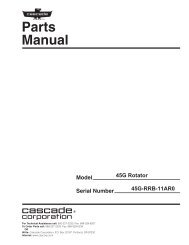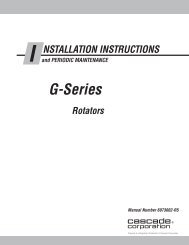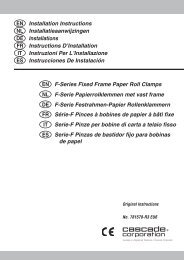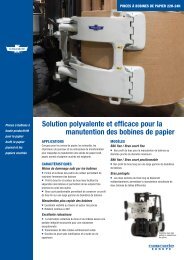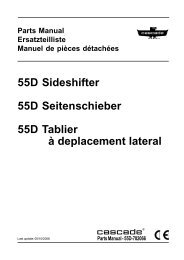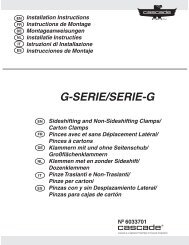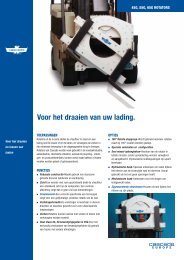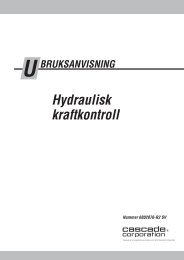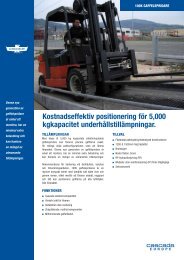150H Fork Positioner - Cascade Corporation
150H Fork Positioner - Cascade Corporation
150H Fork Positioner - Cascade Corporation
You also want an ePaper? Increase the reach of your titles
YUMPU automatically turns print PDFs into web optimized ePapers that Google loves.
T ROUBLESHOOTING<br />
4.3 <strong>Fork</strong> Position<br />
Function<br />
There are five potential problems that could affect the fork<br />
positioning function:<br />
• <strong>Fork</strong>s or fork carriers binding in carriage grooves.<br />
• Incorrect hydraulic pressure or flow to the Attachment.<br />
• External leaks.<br />
• Loose electrical connections or defective solenoid<br />
coil or valve (if equipped).<br />
• Worn/defective cartridge valves or cylinder seals.<br />
4.3-1 Supply Circuit Test<br />
1 Check the truck pressure at the carriage hose terminal.<br />
Pressure must be within 100 psi (7 bar) of that<br />
specified in the truck service manual. TRUCK PRES-<br />
SURE MUST NOT EXCEED 2600 PSI (180 BAR). See<br />
Section 6.1 for recommended operating pressure.<br />
2 Check the flow volume at the carriage hose terminal.<br />
See Section 6.1 for recommended flow volume.<br />
3 Spread the forks fully and hold the lever in the OPEN<br />
position for 2 seconds. Release the lever and check<br />
for external leaks at fittings, hoses, valve and manifold.<br />
4.3-2 <strong>Fork</strong> Position Circuit Test<br />
1 Press the solenoid button (if equipped) and listen for a<br />
‘click’ at the solenoid valve. If no sound is heard,<br />
check the fuse, wiring and coil (see Section 4.5).<br />
IMPORTANT: Solenoid-operated valves must be<br />
plumbed so that the solenoid is energized during the<br />
fork-positioning function.<br />
2 Open and close the forks fully. If the forks move at<br />
different speeds, adjust the flow restrictors for equal<br />
fork speed (see Section 2, Installation Instructions,<br />
Step 12 for procedure).<br />
3 Turn the truck off and connect a 5000 psi (345 bar)<br />
pressure gauge to the ‘tee’ fitting below the valve.<br />
4 Start the truck and spread the forks fully. Hold the<br />
lever in the OPEN position for a few seconds.<br />
5 Release the lever and watch the pressure gauge:<br />
• If the pressure drop is less than 150 psi (10 bar)<br />
initially, and additional drop does not exceed 25 psi<br />
(2 bar) per minute, the problem is not hydraulic<br />
(see Section 4.3 above).<br />
• If the pressure drop is more than above, one of the<br />
cross-over relief cartridges may be faulty. Replace<br />
both cartridges.<br />
6 Close the forks fully and hold the lever in the OPEN<br />
position for a few seconds. If the pressure still drops<br />
as before, the cylinders are at fault and must be<br />
serviced (see Section 5.3).<br />
WARNING: Before removing hydraulic<br />
lines or components, relieve pressure in<br />
the hydraulic system. Turn the truck off,<br />
and open the truck auxiliary control<br />
valves several times in both directions.<br />
14 219473 Rev. 1<br />
2 Flow<br />
Meter<br />
Rear (Driver’s) View<br />
<strong>Fork</strong> speed<br />
adjustment flow<br />
restrictors (2)<br />
2<br />
4<br />
Front View<br />
Pressure<br />
Gauge on<br />
Valve ‘Tee’<br />
Fitting<br />
FP0187.ill<br />
FP0186.ill<br />
3


